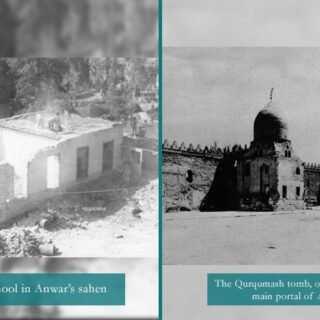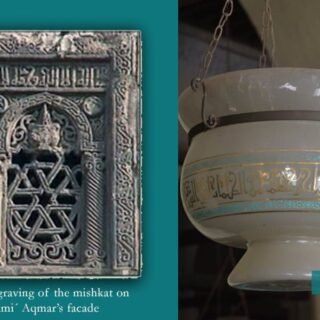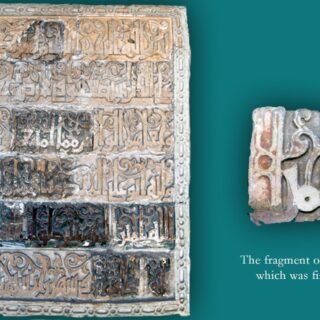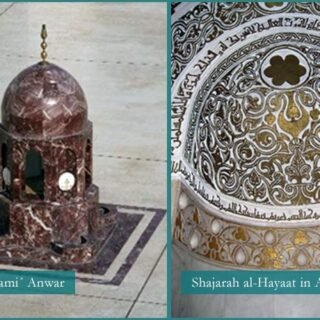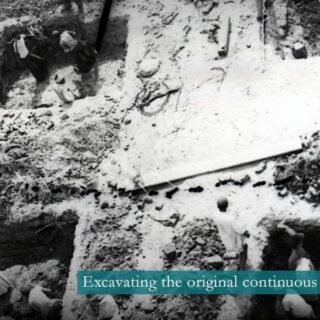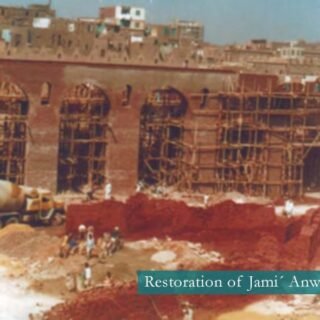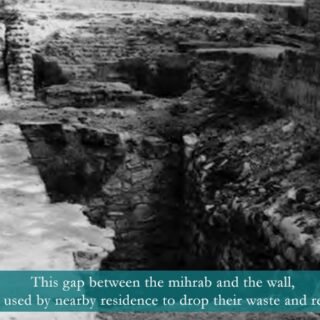Aashuraa’s waaz mubarak expounded upon the eighth and ninth miracles of Jami´ Anwar: the relocation of the school from its courtyard and the removal of the Qurqumash mausoleum from in front of the masjid’s main portal. Centuries of neglect had left the masjid in ruins, and gradually the noble ideal of it being a sacred place of worship was lost to a succession of abuses. One such abuse was the construction of a school, its basketball court and football pitch all in the masjid’s courtyard.
A Comprehensive Education
A masjid has and always will be a centre for learning and the dissemination of knowledge. The establishment of the masjid of Al-Azhar and its university is a prime example of the Fatemi Imams’ concern and regard for learning. However, the sanctity of the masjid must always be preserved. In the instance of Anwar, the school, known as Madrasah Sulehdar, and its attendant noise and play of 5000 children were not at all in keeping with its reverence and had to be removed. Its removal was contentious, and it took a tragic event to coalesce the wills of the parties involved. A young boy lost his life playing on the wooden beams stored for construction. The local populous was enraged and the contractor requested Syedna Mufaddal Saifuddin TUS to leave the site out of fear of reprisal. Syedna al-Dai al-Ajal TUS stated, ‘Where away from this masjid can I find refuge?’ At that instant, he also remembered that it was Imam Hakim AS who had come to the aid of a lonely Mumin calling for him from a remote masjid in Egypt. Syedna TUS remained resolute and, eventually, the tense situation was becalmed. The upshot of the whole episode was that the school’s removal was decided and, finally, a signboard was placed on the structure proclaiming it to be Jami´ Anwar, the masjid of Imam Hakim AS.
The theme of teaching and education for which a masjid stands for, and which the school in this context was failing to do, was explored. The essence of all knowledge and understanding is recognizing that Imam Husain AS sacrificed everything for the faith’s eternal survival. It is by virtue of his sacrifice that we are Mumineen today and, thus, are able to realize our ultimate purpose in this world. This is the benevolence of Imam Husain AS upon us, one that is ingrained in each and every part of our body and soul; a benevolence to be remembered in every day and age. Each Mumin is able to recite Imam Husain’s AS shahaadat regardless of their level of temporal or spiritual attainment. It is this education, that is itself a complete one, regardless of what other fields of expertise one may or may not possess.
It was this education that was given to us by Maulatona Fatema AS when she counseled us to adhere to the ‘corner of the home’: remain steadfast to our traditions and values. Upon this firm foundation, Mumineen, through their thought and contemplation, are able to reach the far corners of the universe. It is with this philosophy of education in mind that Aimmat Tahereen SA established Al-Azhar University in Al-Qaaherah; taking the faithful to the stars and beyond.
Following in the footsteps of the Fatemi Imams AS , their Duat Mutlaqeen enjoined upon Mumineen to decorate their souls with the pearls of knowledge, establishing schools and madrasas and ensuring that the education process was thorough and comprehensive. Like his predecessors, the 52nd Dai Mutlaq, Syedna Mohammed Burhanuddin RA, offered and encouraged Mumineen to benefit from all forms of knowledge, not only deeni taalim (religious education). He showed how the principles and teachings of faith lead to the betterment of the temporal world, for Amirul Mumineen AS has said:
It is all the better when the spiritual and temporal worlds go hand in hand. May Allah never bless a dunyaa (temporal world) that has no element of deen (faith) in it.
The 48th Dai Mutlaq, Syedna Abdulhusain Husamuddin RA, whose birth was on the Day of Aashuraa’, stated that the more learned one is, the greater his grief for Imam Husain AS. When Amirul Mumineen AS passed through Karbala, while returning from the Battle of Siffeen, his grief for Imam Husain AS for so great that it caused him to lose consciousness. Syedna al-Dai al-Ajal TUS addressed Mumineen as seekers of knowledge. In doing so, he made explicit the type of knowledge that is to be sought and the signs and indications that signify whether one has acquired it.
The emblem of Aljamea-tus-Saifiyah (pictured below) bears the aayat:
كُونُوا رَبَّانِيِّينَ بِمَا كُنتُم تُعَلِّمُونَ الكِتَابَ وَبِمَا كُنتُم تَدرُسُونَ
‘Attain divinity by virtue of you being taught the kitaab (book) and through your study of it’.
Syedna TUS explained, that the word رَبَّانِي means a person who has attained an eternal existence, by acting in accordance with what he has learnt, affirmed his servitude to Allah and instilled in himself humility. He then narrated the conversation that took place between Khadir AS and Moosa AS while they sat by the Furaat (Euphrates) river. As they sat, a bird perched itself on a branch which then stooped allowing the bird to sip from the river. Khadir AS said to Moosa AS, ‘I am the branch, you are the bird, and the river is the knowledge of Mohammed Rasulallah SA.’ Imam Husain AS attained shahaadat by the Furaat, and it is the knowledge of his shahaadat and the meanings entailed in it by which a Mumin has been blessed.
Like the shohadaa’ on Ashuraa’, Hudood Fodalaa’ like Syedna al-Khattaab RA, Syedna Mohammed b. Taher RA, Syedi Fakhruddin Shaheed QR, Syedi Hasanfeer QR, Maulaya Raj QR, Syedi Abdulqadir Hakimuddin QR and Syedi Khanji Feer QR exemplified the fact that the highest level of educational attainment is reverence and humility before the Dai. It is on the basis of this knowledge, that we are able to adhere to the tenets of sharia. This knowledge gives us the resolve to refrain from all that is haram, such as interest, in all its forms, and intoxicants. It also urges us to ensure that any meat we consume is halal, its zabihat has been done in accordance with sharia. It is this knowledge that purifies our intentions and conscience, ultimately enabling us to reach the presence of Maula, seen in the series of events which took place when one of Imam Tayyib’s AS followers proceeded to sell a rock crystal vase. Likewise, it establishes for us that attaining Maula’s happiness and complying with his wishes is what grants one the tawfeeq to undertake life-giving acts such as sadaqah, as we heard in the instance of the Aaraabi.
It is this education that enables us to better define and set our priorities. Like the aged lady who toiled day and night to earn the large sum to pay the toll imposed by the Abbasid Caliph on all those wishing to do the ziyarat of Imam Husain AS in Karbala. When she had gathered the stipulated amount of 500 uqiyat – an uqiyat is one ounce of silver; a silver coin weighing one ounce –she immediately set out. She had no steed, her clothes were ragged and no footwear to speak of. As she crossed the checkpoint she was summoned by the caliph himself who happened to be there at the time. The caliph advised her that she should have waited longer, maybe a year or two, until she had earned enough to avail of a mount along with other requirements for a comfortable journey. Rebuffing his short-sightedness, she replied, ‘I am already of an old age. I do not know when my time in this world will come to end. If I were to pass away, then my heartfelt desire for doing the ziyaarat of Imam Husain AS would go unfulfilled’. When he heard her story his stance softened and he reduced the toll from 500 to 2 uqiyat.
The Shortest Path
The 96th surah of the Quran commences with ‘Read, in the name of your Lord’, and ends with the directive ‘prostrate yourself [before Him] and draw near [to Him]’, thus, highlighting the essence and outcomes of all scholarly endeavours: attaining closeness to the Lord. A sajdah is the most difficult of acts for it involves placing one’s forehead, the highest part of his body, upon the earth he walks on. Imam Husain AS stated, ‘The shortest path towards Allah, is that which is the most difficult one’. Syedna TUS named the various routes that can be taken for scaling Tanzania’s Mount Kilimanjaro, pointing out that the shortest path is the most challenging one.
It is through obedience that one attains nearness to the Almighty. This was the path taken by Maulaya Adam QR upon receiving Syedna Idris Imaduddin’s RA directive that henceforth the raza for all Hind will remain with the water-bearer in Maulaya Adam’s QR home. As soon as he received this directive, Maulaya Adam QR showed him the reverence and respect a servant shows for his master. When the time for namaaz came, many were of the view that they should wait a day or two so that the water-bearer could be prepared for leading prayers. Maulaya Adam QR brushed aside such suggestions, and countered that the water-bearer knows some of the shorter surah, and can, therefore, lead us in prayer. When news of his exceptional conduct reached Syedna Idris RA, he gathered all those in his presence, ‘Is there any amongst you who shows such obedience, reverence and humility?’ It was, ultimately, such ikhlaas (purity and sincerity) that brought the seat of Dawat to Hind.
Both Imam Hasan AS and Imam Husain AS undertook a number of hajj pilgrimages on foot. Whenever the faithful passed by them, they too alighted from their mounts out of reverence for them both. However, walking soon proved to be tiresome for many. A request was made to both Imams to ride for the remainder of the journey. They replied that they had taken it upon themselves to undertake the hajj on foot, and, out of consideration for their fellow pilgrims, switched to a less frequented path.
Similarly, Imam Hasan AS took the difficult path of entering into a treaty with Muawiyah. Likewise, Imam Husain AS was urged by the faithful to journey to Yemen, instead of Karbala, where a loyal following resided. And, if he was determined to set out towards Kufa, then at least he leave the women and children of his family behind. The Ahle Bait AS and Ashaab AS of Imam Husain AS also showed similar discernment. On the eve of Aashuraa’, when Imam Husain AS directed them all to depart in the darkness of night, not one of them left. On the day of Aashuraa’ when Imam Husain AS denied them raza mubarak to go in to battle, they did not give up or venture out without raza but instead came before him with various forms of waseelah (intermediaries). Finally, at the time of ´asr, when Jibraeel came before him, accompanied by malaa’ikat offering their khidmat, Imam Husain AS sought the shortest path to Allah by asking Jibraeel where His will lay.
Maqtal
The 9th aayat of Jami´ Anwar’s restoration was the removal of the Qurqumash mausoleum that had been constructed directly in front of the masjid’s main portal. This structure denied us the opportunity to behold the beauty of the main portal.
The revelation of the main portal, and its restoration to its former glory indicated that the effulgence of Imam al-Zaman AS had also spread far and wide. Syedna al-Dai al-Ajal TUS beseeched Imam al-Zaman AS, that like Jami´ Anwar, he and thousands of Mumineen with him, eagerly await the glorious day in which they may glimpse his countenance. He narrated how the 20th Dai Multaq, Syedna Hasan Badruddin RA, in a letter to the Mumineen of Hind, bestowed them with the tidings of Imam’s AS imminent zuhoor. Maula TUS directed us to prepare, and guided our preparations by mentioning that the essence of all of ´ibaadat and acts of repentance is the grief of Imam Husain AS. Furthering our preparations, he counseled us to maintain taqwaa and optimise all opportunities for khidmat. He commended how Mumineen, following the wafaat of Syedna Mohammed Burhuddin RA and in a time of great difficulty, are ever ready to expend all that is theirs. They respond with ‘labbaik’ and immediately comply with Maula’s wishes. Finally, transforming the droplets of our deeds into oceans of divine reward, he stated ‘I take pride in your mohabbat, your ikhlaas, your tafaadi, the attentiveness with which you listen to bayaans, the incessancy of your tears, and in your expression of noh and aweel; I take pride; I take pride; I take pride. May Allah keep all of you safe; out of harm’s way.’
The removal of the obstructing structure also enabled the radiance of Imam Husain’s AS grief to spread throughout the world. It opened the doorway to the overwhelming expression of noh and aweel by Mumineen. The days and nights of Asharah Mubarakah spent in the bukaa’ and maatam of Imam Husain AS, in affirming the pre-eminence of Awliyaa’ Allah AS, and in furthering our commitment to the teachings of Islam and Fatemi philosophy, removed the structures constructed by misleading ideologies that obstructed and hindered our perception. Their removal allowed us – during the time of ´asr on the day of Aashuraa’ – to behold the baab, doorway, to Imam al-Zaman, the portal to salvation, Syedna Aali Qadr Mufaddal Saifuddin TUS with a greatly enhanced level of m´arefat: understanding and comprehension.
The illumination of our souls with the radiance of the luminous masjid: Jami´ Anwar, empowered us to perceive in Maula the radiance of Panjatan Paak AS, their Imams AS and their Duats AS. We realised the reason why Anwar was revived and restored. It was so that the barakat of Imam Husain’s AS bukaa’ and maatam reaches every Mumin, and in turn revives their souls and, ultimately, restores them to their heavenly abode. All with the streak of a solitary tear.

